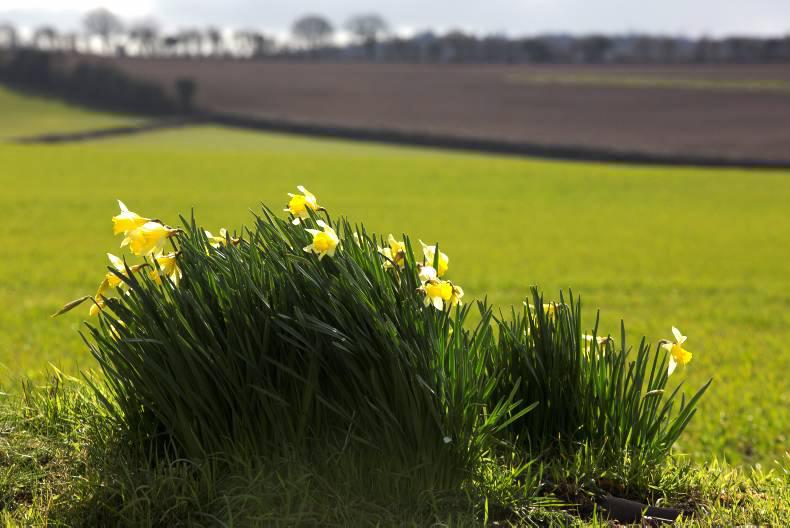A bush of corylopsis in full flower in spring is an unforgettable sight. Every branch and twig carries dangling pale-yellow flowers. The effect of the flowers is soft, almost hazy – a cloud of blossoms. The effect of the flowers is heightened by being carried on bare twigs before the leaves. From first flowers opening to the arrival of obscuring leaves is about three weeks, similar to the show that spring-flowering cherries offer, but while the cherries are widely grown, this lovely plant is not.
The name corylopsis means “hazel-like” and the bush does look very like hazel in outline, only smaller. It is not related to hazel but it is related to witch hazel, or hamamelis, which also looks like hazel and flowers in late winter and early spring. Corylopsis is a perfect follow-on and needs much the same treatment and soil as witch hazel. Some species form a medium bush, suitable for any garden, and others are bigger, making a small bushy tree that needs space and would suit a country garden well. Corylopsis is a very natural looking plant and suits a semi-natural setting.
The most commonly available species is Corylopsis pauciflora, which forms a small broad bush to about chest height but more than two metres wide. This one is sometimes known as the buttercup witch alder, so-called because the short catkins of flowers that are shaped like small yellow bowls, somewhat reminiscent of buttercup flowers, though more of a primrose yellow than the bright yellow of buttercups. Similar but somewhat bigger, Corylopsis spicata has longer catkins. There is not much to choose between them and both kinds are extremely beautiful, the trailing catkins lending drama, the soft colour of the catkins being very pretty. They look almost too delicate to be open so early in the year.
The much larger Corylopsis sinensis, sometimes called Corylopsis willmottiae, forms a small tree or big bush in a fairly short period of years and then stays relatively small, flowering profusely each spring. The bush or small tree can reach to over four metres in height and width. This species especially looks very like a true hazel tree – a twiggy sort of structure with lots of shoots from ground level, like hazel.
Its flowering builds up each year and, when mature, every twig drips with catkins of flowers. The catkins are up to finger length. The flowers have a light sweet fragrance. The colour is a pale lemon yellow. When out of flower, the foliage is quite pretty and the bush is shapely. The yellow autumn colour of the leaves is quite good too, similar to the related witch hazel, which is noted for autumn colour.
All corylopsis species are native to woodland, scrubby land and forest edge in China and Japan. They need acidic soil, as witch hazel itself does. The ideal soil would be acidic, well drained and well supplied with leafy humus. But do not give a lot of shade. The light levels in this country are already low most of the time. It is best planted in an open, bright position, though not exposed, where it will flower more. It looks good with the sunlight highlighting the flowers.
In flower, corylopsis stands out like a beacon, so choose a spot where it will be seen. Plants are sold at this time of year, but hard to get at other times. CL
Climbing snails
Snails are good climbers, often to be found sheltering in a nook high on an old stone wall, but they also climb to reach food and that includes the flowers of daffodils and other spring bulbs. The snails climb the flower stems and feed on the petals, sometimes eating them completely, often just tattering the flowers and spoiling their appearance.
Daffodils are poisonous to mammals, and grazing livestock will not touch them, and there are recorded deaths due to mistaking the bulbs for onions. But the snails seem immune to the poisonous compound or perhaps the flowers carry less poison. It is known the bulbs carry a higher concentration of poison. There is no need to do anything about this as the damage is done when noticed, but if it occurs year after year, some control measures can be taken. Sometimes the culprit snail can be founded resting by day in the flower trumpet.
Fruit, vegetables & herbs
Control weeds around fruit trees and bushes as weeds and grass reduce growth. Sow vegetable seeds of most kinds if conditions allow and the soil is dry enough to till. Onion sets can be put in now. Potatoes can be planted at any time. Spray apple trees against apple scab disease.
Trees, shrubs & roses
Bush roses and repeat-flowering climbers are growing strongly and should be sprayed against blackspot disease. Evergreen trees and shrubs, both broad-leaved and coniferous, can be planted and they will root quickly, but be sure to give a good watering at planting and two weeks later.
Flowers
Gladiolus and dahlias can be planted directly outdoors from the middle of the month. Wait for a while in the colder localities. Lilies can also be potted up for summer flowers. It is too late to sow bedding flowers because they will flower very late. Wait and buy well-grown fresh plants in May.
Lawn
Lawns may need feeding in most cases, unless showing green. Mowing should be under way. Use lawn moss killer if there is heavy moss growth. If the lawn is to be maintained as a short cut wild flower lawn, do not use fertiliser as it makes the grass grow at the expense of the wild flowers.
Greenhouse & house plants
Sow seeds of sweet and chilli peppers. If there is a delay past early April, it’s better to wait and purchase plants. Feed and water heavily all greenhouse plants, if not already done. Around the mid-month is the time to sow sweet corn and runner beans for planting out at the end of May.






SHARING OPTIONS